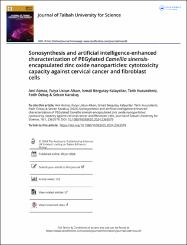Sonosynthesis and Artificial Intelligence-enhanced Characterization of PEGylated Camellia Sinensis-Encapsulated Zinc Oxide Nanoparticles: Cytotoxicity Capacity Against Cervical Cancer and Fibroblast Cells

View/
Access
info:eu-repo/semantics/openAccessDate
2024Author
Asmaz, AnılÜstün, Fulya Alkan
Kalaycılar, İsmail Bergutay
Küçükdeniz, Tarık
Özbaş, Fatih
Karakuş, Selcan
Metadata
Show full item recordCitation
ASMAZ, Anıl, Fulya ÜSTÜN ALKAN, İsmail BERGUTAY KALAYCILAR, Tarık KÜÇÜKDENİZ, Fatih ÖZBAŞ & Selcan KARAKUŞ. "Sonosynthesis and Artificial Intelligence-enhanced Characterization of PEGylated Camellia Sinensis-Encapsulated Zinc Oxide Nanoparticles: Cytotoxicity Capacity Against Cervical Cancer and Fibroblast Cells". Journal of Taibah University for Science, 18.1 (2024): 1-17.Abstract
In this study, we investigated the cytotoxicity of zincoxide nanoparticles (ZnO NPs) encapsulated
in PEGylated Camellia sinensis extract (CL) against L929 fibroblasts and HeLa cervical cancer cells.
Characterization results revealed that the CL/ZnO NPs maintained a spherical morphology with
an average diameter of 40±5 nm. Moreover, advanced computer vision and texture analysis
have provided intricate details regarding the surfaces of CL/ZnO NPs, revealing crucial morphological
features and distribution patterns that are essential for understanding their interactions
with cellular structures. Statistical evaluation revealed a pronounced cytotoxic effect of CL/ZnO
NPs on HeLa cells, with IC50 values of 13.708 μgmL−1 at 48 hours, compared to >100 μgmL−1
for L929 cells, indicating selective anti-cancer activity of NPs with minimal impact on fibroblast
cells. These findings not only highlight CL/ZnO NPs as effective candidates for anti-cancer therapy
but also highlight the synergistic power of combining biotechnology with AI-driven imaging
for cancer treatments.


















